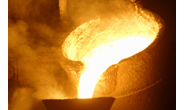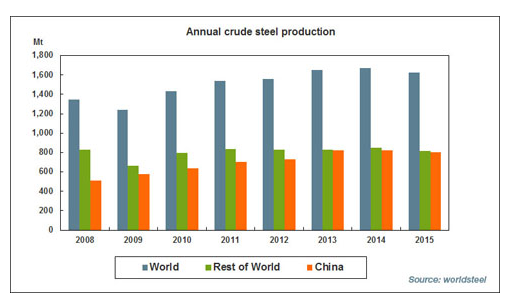International Steel Mills

China Steel Capacity Cuts Promised
Written by Sandy Williams
February 9, 2016
China’s Ministry of Commerce says it will take will take definitive steps to cut steel production over the next five years by 100 to 150 million tonnes. China’s excess steel capacity has been has been estimated to be around 300 million tonnes.
With domestic demand down, steel production has found its way into exports that have set off a wave of trade cases against the world’s largest steel producing country.
![]() In addition, coal burning manufacturing has made air quality intolerable in many urban areas of China. Shutting down excess steel production will, hopefully, make an impact on the country’s environmental problems. According to a report by the China Spectator, official statistics state that 20 percent of China’s steel mills do not meet new environmental standards. Of that group, 40 percent do not have sufficient resources to meet standards.
In addition, coal burning manufacturing has made air quality intolerable in many urban areas of China. Shutting down excess steel production will, hopefully, make an impact on the country’s environmental problems. According to a report by the China Spectator, official statistics state that 20 percent of China’s steel mills do not meet new environmental standards. Of that group, 40 percent do not have sufficient resources to meet standards.
Coal production capacity is to be cut by “a large extent” said the State Council and will include denying approval for new coal mines and expansion. The government also said it will reward companies in both industries that restructure to eliminate overcapacity. Local government are expected help steel mills shutdown outdated capacity in “zombie mills” and upgrade mill technology.
Estimates are that about 400,000 jobs will be lost through the restructuring of the Chinese steel industry. Early retirement is encouraged and the Central Government is stepping up plans to provide resettlement, retraining and financial compensation for displaced workers. Providing financial support and retraining is something new for China and may be what is needed to spur change at the regional level.
Losses have been crushing at Chinese steel mills and only three of the ten biggest Chinese steel producers are expected to show profit for 2015. Although the EU and U.S. have been clamoring for years for China to cut output, the financial reality has finally hit home for the Chinese steel industry.
The World Steel Association reported China crude steel output decreased 2.3 percent to 803.8 million tonnes in 2015 but its share of world crude steel production increased from 49.3 percent in 2014 to 49.5 percent in 2015.
The proposed cuts in production have analysts debating whether it will be enough, and soon enough, to balance world steel trade.
Bloomberg gathered comments from analysts Capital Economics Ltd. and Macquarie Group Ltd.
Caroline Bain, senior commodities analyst at Capital Economics, said that “The announcement is actually a disappointment. Now that we know this is intended to happen over five years, the immediate market impact seems minimal and could actually be negative.”
Colin Hamilton, head of commodities research at Macquarie, told Bloomberg that the world needs 200 million tons to 250 million tons of capacity cuts. “China’s still going to be exporting steel and associated deflationary pressures for a while,” said Hamilton.
Keith Tan, Managing Editor of Steel and Raw Materials at Platts, McGraw Hill Financial said in a recent blog that although there are skeptics, “many signs point toward a resolve by the state that is unwavering.” Tan notes that the highest levels of the Chinese administration, the president and premier, have pledged to tackle the problem unlike previous announcements by lower level officials. Furthermore, he writes, a plan is in place to help displaced workers and the government has finally recognized that rapid-over-investment in the steel sector has resulted in staggering losses by steelmakers.
Wrote Tan in a tip of the hat to the Chinese New Year of the Monkey, “Perhaps they’ll prove to be sharper-toothed this time, as Beijing wags its finger and says no monkeying around.”

Sandy Williams
Read more from Sandy WilliamsLatest in International Steel Mills

Global steel mill output steady through May
Global raw steel production rose 2% from April to May, slightly above average production levels seen in recent months, according to data recently released by the World Steel Association (worldsteel).

Trump says US government to control 51% share in USS
President Trump says the US government will hold a 51% stake in U.S. Steel after the Nippon deal.

USS, Nippon Steel quiet as litigation deadline approaches
There has been little word from U.S. Steel, Nippon Steel, or the White House since President Trump endorsed the companies’ “partnership” on social media and celebrated it at the May 30 rally outside Pittsburgh.

Ternium’s Vedoya named AIST’s Steelmaker of the Year
Maximo Vedoya was awarded in recognition of Ternium’s expansion project in Pesquería, Mexico, and Ternium’s efforts to decarbonize steelmaking.

CRU: Baosteel hints at output cuts in China
Baosteel exec comments on market rumors of 50 million tons of output being cut this year, less than 0.5% of the 1 billion tons-plus China has produced annually in recent years.

